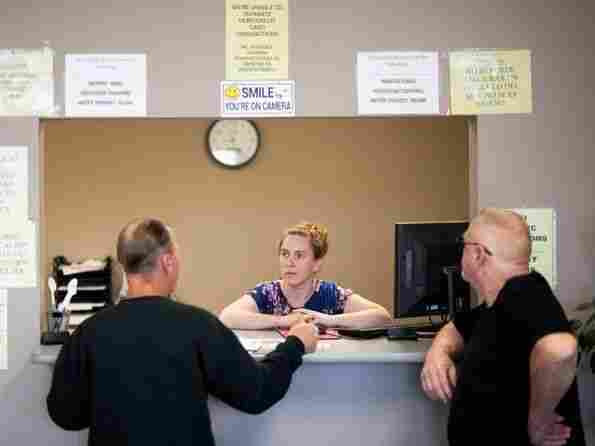Kentucky Derby Jockeys Look For New Ways To Shave Off Time
The Kentucky Derby is fast. Really fast. The famed horse race is often won by fractions of a second. This has owners, trainers and jockeys looking for any way they can cut time.
AILSA CHANG, HOST:
Tomorrow marks the 145th Run for the Roses, better known as the Kentucky Derby and often referred to as the fastest two minutes in sports. In past years, the race has been won by less than a second. While there’s plenty of debate over the impact of performance-enhancing drugs, Ashlie Stevens of member station WFPL in Louisville wondered – what are some other ways jockeys, owners and trainers shave seconds off race time?
ASHLIE STEVENS, BYLINE: In the days leading up to the Kentucky Derby, horses and their trainers parade through the paddock on their way to and from the track for practice runs.
(SOUNDBITE OF HORSE TROTTING)
A. STEVENS: For now, the horses are moving at a pretty slow pace.
(SOUNDBITE OF HORSE WHINNYING)
A. STEVENS: But on Saturday, that won’t be the case. These horses are 1,000-pound elite athletes. And this race is just as competitive as any marathon or Olympic swim. Since its start in 1875, there are numerous examples of the derby being won by a fraction of a second. Which made me wonder – has anyone ever shaved their racehorse to get a better time, like how some human endurance athletes shave excess body hair to eliminate drag?
CHRIS GOODLETT: To my knowledge, there’s never been hair shaved off a horse to save seconds.
A. STEVENS: That’s Chris Goodlett, the chief curator at the Kentucky Derby Museum.
GOODLETT: I don’t know if it’s written rule – maybe because of the absurdity – but my guess would be it would be frowned upon.
A. STEVENS: Goodlett says, ultimately, the Jockey Club, the governing body of professional horse racing, probably wouldn’t approve of a bald horse. They can get sunburns, and owners are prevented from making any major alterations to a horse’s appearance – though there are plenty of other modifications trainers and jockeys have made for faster runs, such as using lighter horseshoes. Gary Stevens is a retired three-time Kentucky Derby-winning jockey.
GARY STEVENS: They’re not steel shoes. They are aluminum. And they are very, very lightweight. And they have toe grips on the front and grips on the rear end as well.
A. STEVENS: Stevens also says jockeys’ colorful shirts have undergone some aerodynamic updates since the 1980s. The silks now fit much tighter, like what bicyclists wear.
TERESA ESTES: The aero fits tighter to the body, so you don’t have it flapping in the wind when the horse is running.
A. STEVENS: That’s Teresa Estes. She and her business partner run Triple Crown Silks in Winchester, Ky. They are designing silks for three Derby hopefuls this year. Estes says many racehorse owners now want something more tailored to the jockeys’ bodies to reduce drag.
ESTES: In the satins, you can’t do that because there’s no stretch to it.
A. STEVENS: More of their clients are shifting away from those traditional race day materials to more aerodynamic fabrics.
Even with all the improvements, jockey Gary Stevens says a large part of the Kentucky Derby is still the luck of the draw, specifically the draw for post positions, or which gate the horses get to start out of. The worst one is closest to the inside rail.
G. STEVENS: And the one hole is dreaded in the Kentucky Derby because if you don’t break well – if you don’t get a good start, it’s like a giant wave of 19 other horses trying to get over close to the rail to safe ground going into that first turn.
A. STEVENS: And even with a good post position, sleeker clothing and lighter gear, Chris Goodlett of the Kentucky Derby Museum says there’s one more thing to try.
GOODLETT: Trainers will all joke with us that if you want more seconds – you want to do a little bit better in the race, you need to buy a faster horse.
A. STEVENS: While having the fastest horse is really the only sure bet for winning the Derby, that won’t keep trainers and jockeys from trotting out new tricks to increase speed.
For NPR News, I’m Ashlie Stevens in Louisville.
(SOUNDBITE OF PARQUET COURTS’ “WIDE AWAKE”)
Copyright © 2019 NPR. All rights reserved. Visit our website terms of use and permissions pages at www.npr.org for further information.
NPR transcripts are created on a rush deadline by Verb8tm, Inc., an NPR contractor, and produced using a proprietary transcription process developed with NPR. This text may not be in its final form and may be updated or revised in the future. Accuracy and availability may vary. The authoritative record of NPR’s programming is the audio record.


